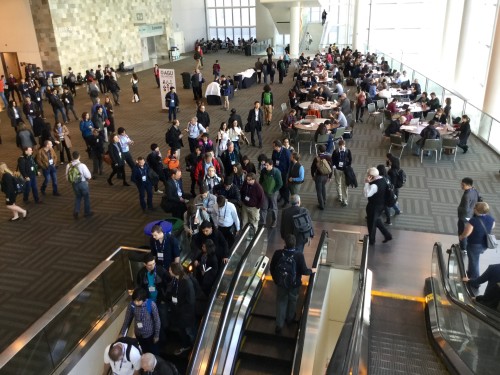
By James Dacey in San Francisco
Droves of delegates poured into the Moscone Center in San Francisco today for day one of AGU Fall 2015 – the largest Earth and space-science meeting in the world, with a whopping 24,000 delegates expected over the week. Having arrived from the UK on Saturday night, the jet-lag has kicked in with a vengeance today, so a couple of the conference coffees were definitely in order this morning. I’m just taking a break now after an interesting session about communicating climate change, and whether those researchers who don’t engage in the public debate are “failing humanity”.
The room was packed to the rafters, no doubt down to the profile of the speakers. First up was James Hansen, the former NASA scientist who has been outspoken in his criticism of the recent COP21 climate discussions, or at least the lack of concrete proposals to cut carbon emissions. Hansen restated his beef with the deal and argued that the only workable solution is for authorities to collect a carbon fee at source, such as charging domestic mines for the weight of carbon they sell. This, he believes, is the most effective way to make renewable energy and low-carbon options more viable. Not one to pull his punches, Hansen described US Energy Secretary Ernest Moniz’s idea that China will be able to curb much of its carbon missions using carbon capture and storage (CSS) technologies as “pure unadulterated bullshit”.
Next to speak was another climate scientist who is no stranger to political confrontation – Michael Mann, famous for producing the “hockey stick” graph showing a global-warming trend since industrial times. Mann is far more optimistic about the agreement reached in Paris and believes that we can still keep the global temperature rise to within two degrees of pre-industrial levels, as the COP deal proposes. Where Mann does agree with Hansen is that climate scientists have a duty to join the political debate, whether it’s thrust upon them or not. “The stakes are too high for us to keep quiet,” he says.
“We tend to adopt a null hypothesis that there is no climate change, then try to reject it,” says Mann. “But that sort of framing may not be appropriate with a problem like climate change where we are dealing with potentially catastrophic outcomes.” Mann believes this inherent conservatism on the part of climate scientists is because of “seepage” from the poisonous atmosphere that surrounds climate science, causing researchers to downplay the risk of a rapidly warming planet.
Instead, Mann believes that climate change needs a new risk-assessment paradigm, and he suggests adopting an approach similar to that of the medical community, where doctors take a precautionary approach operating on the balance of evidence rather than absolute certainty. Hansen chimed in on this point, citing the search for the Higgs boson as an example of an area of science where we could take our time to confirm the findings to several standard deviations. With climate science, we don’t have that luxury, he said.
Other speakers in the session made suggestions for how climate scientists could have more effective influences on the climate debate. Naomi Oreskes, a historian of science at Harvard University, argued that we wrongly equate rationality with dispassion. “Sometimes you need a little drama,” she said. This need for more creative ways of communicating science was an opinion shared by Mark Jacobson, a director of the Solutions Project, which promotes the sustainable-energy sector through online storytelling, social media and celebrity endorsements. Meanwhile, Veerabhadran Ramanathan, an atmospheric scientist who has worked with the Pontifical Academy of Scientists, believes that the key to getting climate change accepted in society is to get the issue on the agenda in places of religious worship.
Keep an eye on this blog for more updates from AGU 2015 over the coming days.
Although the Paris COP21 agreement has to be a good basis to deal with the Earth’s climate problem, here the main difficulty comes, because one often fails to distinguish between one’s “weather” and the notion of the Earth’s climate as a whole: for the weather the temperature fluctuates both up and down, but for the climate, it just goes only one way, on the average, and it has risen 0.85°C since the start of the indutrial revolution and is caused mostly by the rise in the amount of greenhouse gas Co2 in the atmophere as shown by is “hockey curve”.
Trackback: environmentalresearchweb blog - environmentalresearchweb
Trackback: Are reticent climate researchers ‘failing humanity’? – MyPhysNet